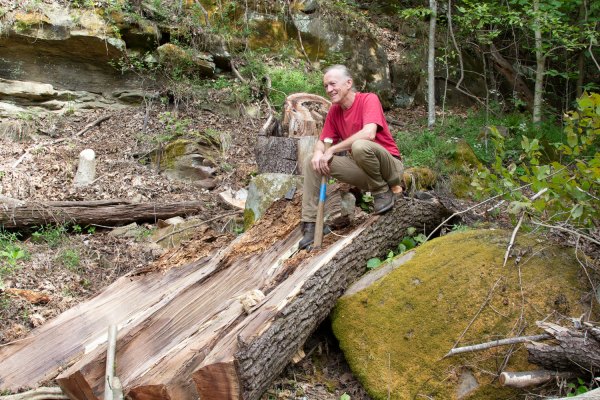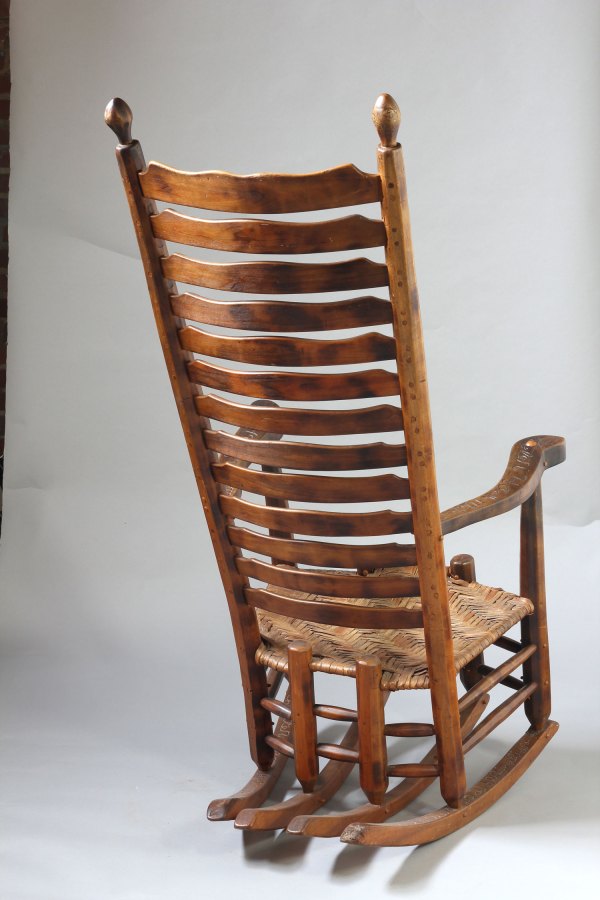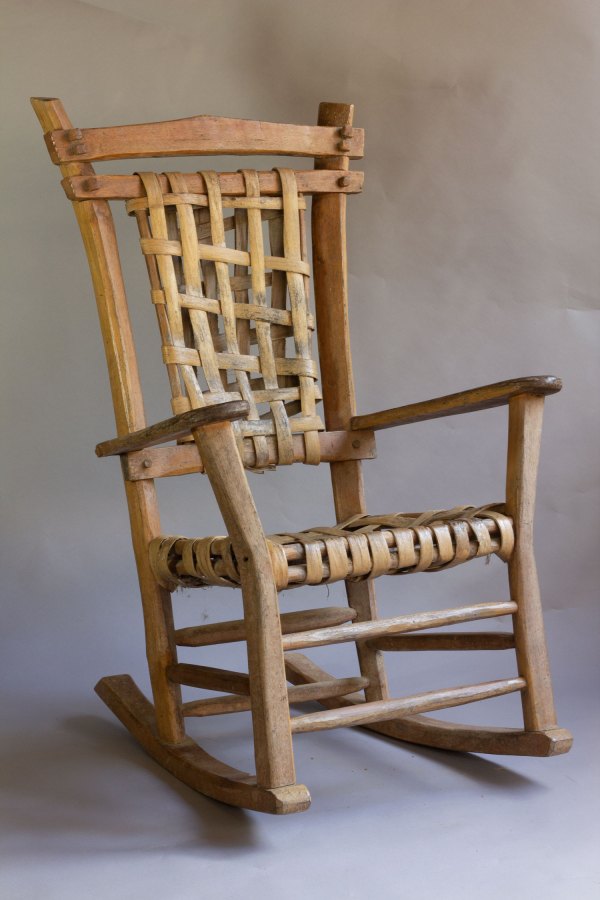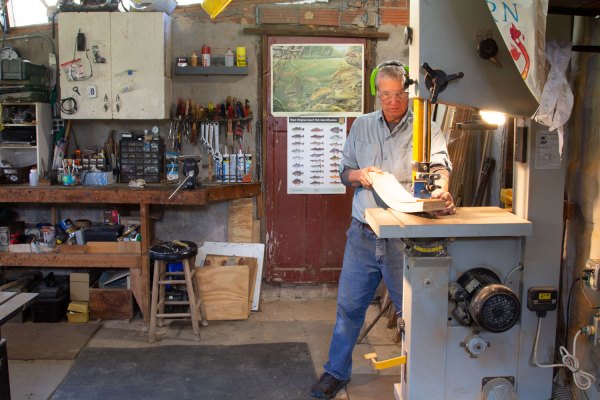
I first reached out to an Appalachian chairmaker in about November 2019. It was before this project came about, before the search started in earnest to find chairmakers in the region. Our initial phone conversation discussed the details about an upcoming two-day visit. I struggled to keep up; the chairmaker’s fast talk and dialect were tough to follow over the phone, especially because he did not get strong service in the mountains and our call dropped a few times. My hope for the visit was to observe, listen, learn and, if at all possible, lend a hand. He outlined a schedule and made a few suggestions for our time.
I asked about local lodging, a place to stay after we worked together. He lives in Eastern Kentucky, which is rural, mountainous and remote. He offered me his guest bedroom, a trusting and generous gesture. The next part of the conversation was memorable, despite the poor connection. I reluctantly accepted his offer to stay, saying I’d be happy to find a local hotel so as not to impose.
He replied, “If things go poorly, I’ll just feed you to the pigs….” *
No follow-up. No laughter. I hoped it was due to the poor connection. My wife made sure I left the chairmaker’s address before leaving for the visit, something to assist the authorities, just in case things did not go well.
*I scanned for barns or signs of livestock upon arriving at his property. None. All clear.

Chris Schwarz asked me to share a little about my upcoming book, “Backwoods Chairs.” The original details of how the idea came together are a little fuzzy, though it had to do with our mutual appreciation for the Appalachian chairmaking traditions. The chairs were the spark that ignited this project.
In “Backwoods Chairs,” I search for post-and-rung chairmakers still working within central Appalachian traditions due to their historic ties to the region (the chairs also go by the name ladderback, hickory-bottom, common and slat-back). But that search proved challenging. Though there’s a rich tradition, the current field of chairmakers is small and dwindling. The makers have little Internet presence, and there is no central information source, such as a person who knows the makers and their locations. I’ve chased dozens of leads and recall laughter on the other end of the phone line as I ask about traditional chairmakers. “Good luck,” they giggle.
Are there makers still out there? Even the chairmakers ask me that question upon hearing about this book project.
There is an abundance of green woodworking in “Backwoods Chairs,” though it’s not all that. Some makers turn their parts from planks, others split and shave. You will find plenty of handwork and hickory bark, a little history and humor within the pages. There are stories about the makers, pictures of their shops and tools, and emphasis on their techniques and their chairs, along with discussion of their successes and hardships. And plenty of chairmaking romance with a dash of capitalism’s ruthlessness. The book’s final section is a step-by-step build of a couple chairs, created for someone with a home shop and lack of backyard access to a deciduous forest full of oaks and maples.

There is another thing that draws me to this project beyond my love of the chairs. It is an attitude that is incredibly tough to capture: that these chairs are somehow (and mistakenly) the bottom rung of creative woodworking. That they are almost worth looking beyond, to find something more impressive. The Ronald L. Hurst article “Southern Furniture Studies: Where We’ve Been, Where We’re Going,” for the MESDA Journal, catches some of that vibe (emphasis mine):
Southern furniture is one of the most dynamic subjects in American decorative arts research today. Institutions and private scholars alike are actively investigating a wide array of the region’s cabinetmaking traditions, and their compelling discoveries are regularly revealed in new publications and exhibitions. Yet interest in the topic is comparatively recent. Antiquarians began collecting furniture from the North as early as the 1820s, but there was almost no awareness of its southern counterparts before the 1930s. Even then, study of the material would remain sporadic for another thirty years. Although a small core of early-twentieth-century southern dealers and collectors was aware of the South’s cabinetmaking heritage, the rest of the American decorative arts community was convinced that southern furniture makers fashioned nothing more complex than ladder-back chairs and utility tables.
The following paragraph, from the same article, continues on this theme of regional furniture ignorance:
Ironically, one of the principal catalysts for a widespread change in attitudes about southern furniture came at the 1949 Colonial Williamsburg Antiques Forum. Joseph Downs, curator of the MMA’s American Wing, addressed that first Forum audience in a lecture titled “Regional Characteristics of American Furniture.” During the question-and-answer session that followed, a participant asked Downs why his presentation on American regional style had included only goods made in the North. Downs reportedly replied that “little of artistic merit was made south of Baltimore.” Either Juliette Brewer or Eleanor Offutt, both knowledgeable Kentucky collectors and preservationists, purportedly offered a follow-up question. “Mr. Downs,” one of them asked, “do you speak out of ignorance or out of prejudice?” Downs graciously pled ignorance, but his then widely accepted view on the subject, stated in that place to that audience, generated outrage and launched a movement that remains alive today.
The MESDA article is in reference to collecting and recognizing the value in Southern furniture. It’s my understanding that high-style Southern furniture is now receiving its due. So some things are changing.

There are significant differences between high-style work and the backwoods chairs. In one, creativity is born out of abundance. The conditions foster beautiful work, yet I am fascinated by creativity out of necessity. Making not in partnership with affluence, but within communities of modest means. Within central Appalachia, the tradition of making out of necessity points directly toward slat-back chairs and their makers. Or at least it did. I’m interested in hearing from the makers about today’s conditions and if they are optimistic about traditional chairmaking continuing forward with future generations.

This project is possible only because the makers generously opened their workshops and shared their stories. They graciously adjusted along with me throughout the uncertainty of the last year. I planned the first visits for this project for spring of 2020 (you remember last spring). Travel was quickly postponed until conditions improved. A couple visits happened last fall, on good weather days when we could distance and be outdoors, with makers in Eastern Kentucky, North Carolina and West Virginia. Upcoming travel includes trips into Tennessee, North Carolina (again) and Virginia. At that point I should have plenty of material for the book.
I have high hopes for “Backwoods Chairs.” I want to do right by the chairmakers, write an engaging and informative book for the woodworking community, and create something worthy of Lost Art Press. Since starting I have added one more aspiration to my list: I intend to stay clear of any hungry pigs.
— Andrew Glenn